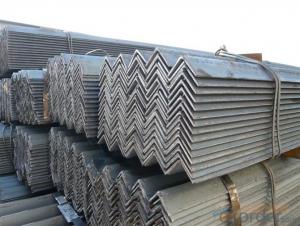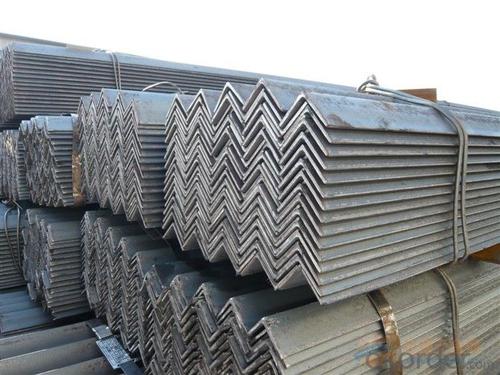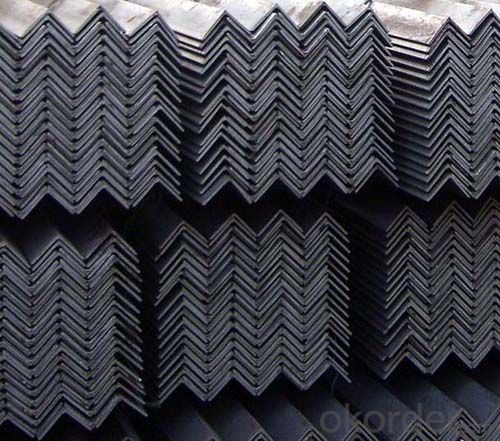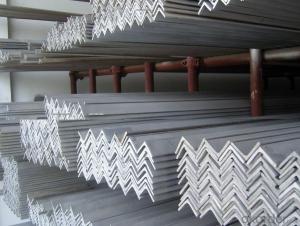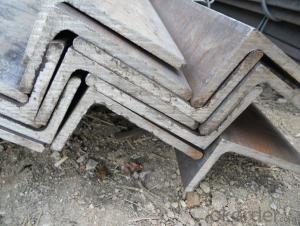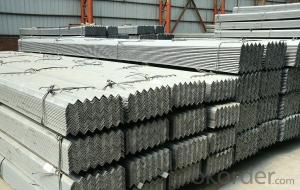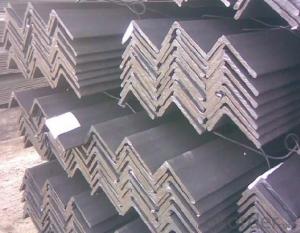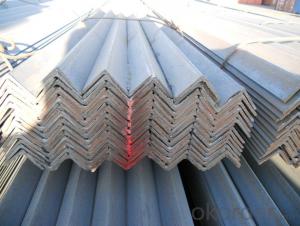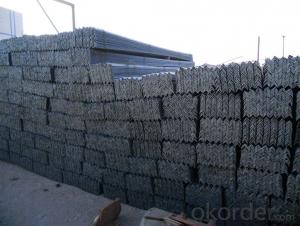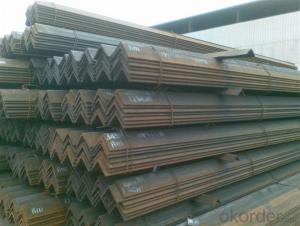GB Q345 Steel Angle with High Quality 90*90mm
- Loading Port:
- Tianjin
- Payment Terms:
- TT or LC
- Min Order Qty:
- 25 m.t
- Supply Capability:
- 10000 m.t/month
OKorder Service Pledge
OKorder Financial Service
You Might Also Like
Specifications of GB Q345 Steel Angle with High Quality 90*90mm:
1.Standards: GB
2.Material: Q345 or Equivalent
3.Length: 6m, 12m
4.Size:
| Size (mm) | Mass (kg/m) | Size (mm) | Mass (kg/m) |
| 90*90*7 | 9.656 | 90*90*10 | 13.478 |
| 90*90*8 | 10.946 |
Usage & Applications of GB Q345 Steel Angle with High Quality 90*90mm:
Trusses;
Transmission towers;
Telecommunication towers;
Bracing for general structures;
Stiffeners in structural use.
Packaging & Delivery of GB Q345 Steel Angle with High Quality 90*90mm:
1. Transportation: the goods are delivered by truck from mill to loading port, the maximum quantity can be loaded is around 40MTs by each truck. If the order quantity cannot reach the full truck loaded, the transportation cost per ton will be little higher than full load.
2. With bundles and load in 20 feet/40 feet container, or by bulk cargo, also we could do as customers' request.
3. Marks:
Color mark: There will be color marking on both end of the bundle for the cargo delivered by bulk vessel. That makes it easily to distinguish at the destination port.
Tag mark: There will be tag mark tied up on the bundles. The information usually including supplier logo and name, product name, made in China, shipping marks and other information request by the customer.
If loading by container the marking is not needed, but we will prepare it as customers' request.
FAQ:
Q1: Why buy Materials & Equipment from OKorder.com?
A1: All products offered byOKorder.com are carefully selected from China's most reliable manufacturing enterprises. Through its ISO certifications, OKorder.com adheres to the highest standards and a commitment to supply chain safety and customer satisfaction.
Q2: How do we guarantee the quality of our products?
A2: We have established an advanced quality management system which conducts strict quality tests at every step, from raw materials to the final product. At the same time, we provide extensive follow-up service assurances as required.
Q3: How soon can we receive the product after purchase?
A3: Within three days of placing an order, we will arrange production. The shipping date is dependent upon the quatity, how many sizes you want and the plan of production, but is typically 30 to 45 days from the beginning of production.
Images of GB Q345 Steel Angle with High Quality 90*90mm:
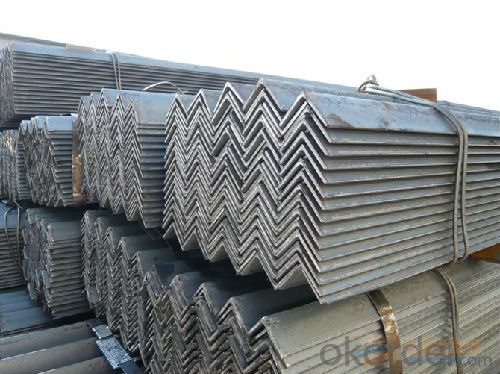

*If you would like to get our price, please inform us the size, standard/material and quantity. Thank you very much for your attention.
- Q: How do you connect two steel angles together?
- Welding is a commonly used technique for connecting two steel angles. It involves melting the angles' edges and joining them using an electric arc or flame, resulting in a durable and permanent connection. Before welding, it is vital to clean the surfaces to remove any impurities or rust. Furthermore, accurately aligning the angles and securing them with clamps or tack welds is essential to guarantee a precise connection. Another alternative for joining steel angles is using bolts or screws. This approach entails drilling holes through the angles and then fastening them together with nuts and bolts or screws. To achieve a strong connection, it is crucial to choose appropriate fasteners and ensure they are tightly secured.
- Q: What are the different types of steel angles used in storage tank construction?
- Storage tank construction commonly utilizes several different types of steel angles, each serving a crucial role in providing structural support and stability. 1. L-angles, also referred to as unequal angles, find wide usage in storage tank construction. Comprising one longer and one shorter side, these angles form an L-shape. They are frequently employed as tank stiffeners, effectively preventing deformation and maintaining structural integrity. 2. T-angles, alternatively known as tee angles, represent another type of steel angle employed in storage tank construction. With a T-shape, one side is long while the other is shorter and perpendicular. T-angles often function as horizontal and vertical bracing members within tank structures, delivering added strength and stability. 3. Equal angles, also called right angles, consist of two equal sides forming a 90-degree angle. Tank construction commonly utilizes equal angles in various applications, such as providing support for tank roofs, reinforcing corners, or connecting tank components. 4. Bulb angles, or bulb flats, boast a unique shape featuring a flat surface and a bulbous section at one end. These angles are frequently employed in tank support structures, notably the tank bottom, to evenly distribute loads and minimize stress concentrations. 5. Rolled steel sections, such as I-beams, channels, and H-beams, are additionally utilized in storage tank construction alongside the aforementioned angle types. Rolled steel sections offer supplementary strength and support to tank structures, particularly in larger tanks or areas with high load requirements. In summary, the choice of steel angles in storage tank construction hinges upon specific design requirements, load considerations, and structural integrity needs. Selecting the appropriate type and size of angles is crucial to ensure tanks can withstand anticipated loads and environmental conditions.
- Q: Are steel angles suitable for scaffolding?
- Yes, steel angles are suitable for scaffolding. Steel angles are strong and durable, making them an ideal choice for supporting heavy loads and providing stability on construction sites. They can be easily connected and assembled to create a stable framework for workers to access higher levels during construction or maintenance tasks. Additionally, steel angles are versatile, allowing for various configurations and adjustments to accommodate different project requirements. Overall, steel angles are a reliable and commonly used component in scaffolding systems.
- Q: Can steel angles be used as bracing elements?
- Yes, steel angles can be used as bracing elements. Steel angles are often used in construction as bracing elements due to their strength and stability. They can effectively provide support and enhance the structural integrity of a building or structure.
- Q: What are the common surface preparations for painting steel angles?
- To ensure proper adhesion and durability of the paint on steel angles, a series of steps are typically taken. These steps include: 1. Thoroughly cleaning the surface: The steel angles must be cleaned to remove any dirt, grease, oil, or contaminants. This can be done using solvents or degreasers, followed by a rinse with clean water. 2. Removing rust: If there is any rust present on the steel angles, it needs to be eliminated. This can be achieved by wire brushing, sanding, or using a rust remover or converter. The objective is to achieve a clean, smooth surface free of rust. 3. Roughening the surface: Steel surfaces are often smooth, which can hinder proper adhesion of the paint. To enhance adhesion, the surface can be roughened by methods such as sanding, abrasive blasting, or using a chemical etching solution. This helps create a better surface for the paint to grip onto. 4. Applying a primer: The application of a primer is crucial for steel angles as it promotes adhesion, prevents corrosion, and prolongs the lifespan of the paint job. The choice of primer should be based on the type of paint being used and can be applied using brushes, rollers, or sprayers. 5. Applying the paint: Once the primer has dried, the paint can be applied. Depending on the desired finish and durability, multiple coats may be necessary. It is important to adhere to the manufacturer's instructions for proper drying times between coats. By following these common surface preparations, the steel angles will be ready for painting, resulting in a long-lasting and visually appealing finish.
- Q: How do you design bracing using steel angles?
- Designing bracing using steel angles involves determining the required strength and stiffness of the bracing members, selecting appropriate steel angles based on their load-bearing capacities, and arranging them in a configuration that effectively resists the applied forces and moments. The design process typically includes analyzing the structure's loadings, determining the required bracing forces, calculating the required cross-sectional area of the steel angles, and verifying the design against relevant design codes and standards. Additionally, considerations such as connection details and fabrication constraints also play a role in designing bracing using steel angles.
- Q: How do steel angles resist corrosion?
- Passivation is the process by which steel angles develop a protective layer on their surface, which helps them withstand corrosion. This layer acts as a barrier against moisture, oxygen, and chemicals that are corrosive to the steel. Typically, steel angles are made from stainless steel, which contains at least 10.5% chromium. Chromium plays a crucial role in the formation of a thin layer of chromium oxide on the steel's surface. This oxide layer is invisible but highly stable, preventing further corrosion. The chromium oxide layer acts as a physical barrier, shielding the underlying steel from the harmful effects of the environment. It is also self-repairing, meaning that if it gets damaged or scratched, it will naturally regenerate and restore its protective properties. Stainless steel angles may also contain other alloying elements like nickel and molybdenum, which enhance their resistance to corrosion. These elements contribute to the formation of a more stable oxide layer and provide added protection against localized corrosion, such as pitting and crevice corrosion. To further enhance their corrosion resistance, steel angles can be treated with various surface finishes or coatings. These treatments, like hot-dip galvanizing, electroplating, or applying organic coatings, create additional layers that act as extra barriers, preventing corrosive substances from reaching the steel surface. In summary, steel angles resist corrosion by forming a protective layer of chromium oxide, which acts as a barrier against corrosive elements. The inclusion of other alloying elements and the application of surface treatments further enhance their ability to withstand corrosion in different environments.
- Q: What is the purpose of using steel angles in construction?
- Steel angles serve various purposes in construction. Their primary function is to offer structural support and stability to different components of a building or structure. Reinforcing corners, edges, and joints, these angles enhance the overall strength and rigidity of the structure. Moreover, steel angles play a crucial role in distributing and transferring loads or forces within the construction. They facilitate the even distribution of weight and stress across various parts of the structure, preventing the formation of weak points. Furthermore, steel angles are highly versatile and can be easily customized and fabricated to meet specific construction requirements. They can be cut, drilled, and welded, seamlessly integrating into a wide range of construction projects. Not only that, but steel angles also exhibit remarkable durability and resistance to corrosion, making them suitable for both indoor and outdoor applications. With the ability to withstand heavy loads and extreme weather conditions, they provide long-lasting support to the structure. In conclusion, the utilization of steel angles in construction aims to enhance structural integrity, provide support and stability, distribute loads, and ensure the longevity of the building or structure.
- Q: Can steel angles be used as support brackets?
- Yes, steel angles can be used as support brackets. They are commonly used in construction and engineering projects to provide structural support and stability. Steel angles offer strength and durability, making them suitable for supporting various loads and reinforcing structures.
- Q: Can steel angles be used in sports or recreational facilities?
- Yes, steel angles can be used in sports or recreational facilities. Steel angles are commonly used in the construction industry due to their strength, durability, and versatility. They are often used in the construction of sports and recreational facilities such as stadiums, arenas, gymnasiums, and indoor/outdoor courts. Steel angles are typically used to provide structural support and stability to the building. They can be used in the framing of walls, roofs, and floors, as well as in the construction of bleachers, seating areas, and staircases. Steel angles can also be used to create barriers, fences, and safety rails, ensuring the safety of athletes and spectators. In addition to their structural applications, steel angles can also be used for aesthetic purposes. They can be used as decorative elements, such as in the design of entrance gates, signage, and lighting fixtures. Steel angles can be painted or coated in various colors or finishes to match the overall design theme of the sports or recreational facility. Overall, steel angles are a versatile and practical choice for use in sports and recreational facilities. Their strength, durability, and aesthetic appeal make them suitable for a wide range of applications within these facilities.
Send your message to us
GB Q345 Steel Angle with High Quality 90*90mm
- Loading Port:
- Tianjin
- Payment Terms:
- TT or LC
- Min Order Qty:
- 25 m.t
- Supply Capability:
- 10000 m.t/month
OKorder Service Pledge
OKorder Financial Service
Similar products
Hot products
Hot Searches
Related keywords
